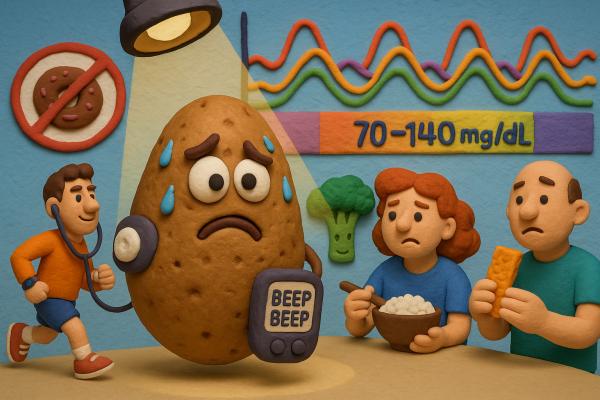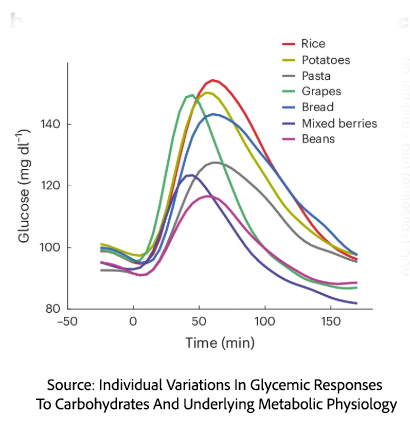
Our bodies maintain glucose concentrations between 70 and 140mg/dl when our metabolic function is normal. Blood glucose rises in response to a meal and then declines back to its baseline, a pattern that CGMs can characterize.
In recent years, telehealth companies have been offering continuous glucose monitors (CGMs) paired with mobile apps to “improve general health.” While offered, presumably after being prescribed by a physician, “off-label,” they serve the same role as CGMs for individuals with diabetes, providing real-time biofeedback to make or enforce lifestyle changes.
The health quantifiers are motivated to use CGMs to
- Identify glycemic patterns outside the typical “normal.”
- Optimize their peak mental and physical performance.
- To serve as motivation to sustain healthy behavioral changes.
While there is a growing consensus that these CGM-derived curves may identify individuals at increased risk of diabetes, PPGR predictions remain problematic due to the high variability of individual responses to identical carbohydrate loads. A meta-analysis of the literature on CGM data for individuals without diabetes has shown:
- CGMs “might facilitate” earlier identification of patients at risk, although a current standardized test and findings are lacking
- CGMs may provide information that can help predict gestational diabetes
- CGMs can provide “biofeedback” to support lifestyle interventions, “including portion control and both timing and quality of food consumed.”
- CGM may promote healthier behaviors and prevent the onset of Type 2 diabetes.
- There is “virtually no evidence” that tighter control of glucose will improve cognitive or physical function. In fact, tighter control of glucose in hospitalized patients is deleterious at times.
No risk and no reward.
The researchers note that there is “virtually no risk to using a CGM,” outside of infrequent tape allergies and its cost – it is not covered by health insurance if diabetes is not already present. The end on this note:
“Two drawbacks to the use of CGMs by people without diabetes are not specifically risks but rather problems with using the data, and these include (1) an absence of consensus standards for defining abnormal values and (2) an absence of consensus standards for how to respond to abnormal values. …
The evidence for CGM use is scant beyond the metabolic and non-metabolic disease domains, and consensus is virtually non-existent outside of diabetes.”
An abnormal response to eating sugars and carbohydrates, a high postprandial glycemic response (PPGR) is the common physiologic response to diabetes and a biomarker of those at risk for diabetes. With the advent of continuous glucose monitors (CGMs), we are learning more about how, what, and when we eat, along with who we are (ethnically and in terms of our microbiome) and how these factors contribute to individual postprandial glucose response (PPGR) profiles.
In 2022, the FDA granted breakthrough device designation to the first commercially available CGM. In addition to its value to individuals with diabetes, a large group of individuals interested in quantifying their health has added a CGM to the Aura ring, Apple Watch, or Fitbit in their health routine. A new study in Nature, using those CGMs, summarizes some of what we have learned about our glycemic responses in the absence of diabetes.
Fifty-five adults with no prior history of diabetes underwent “deep metabolic phenotyping” of their overall, hepatic and adipocyte (fat cell) insulin resistances and beta cell function along with the usual demographics  and information on their microbiome and metabolomics (the metabolites in our blood). They were fed seven different 50-gram carbohydrate meals and three “preloaded mitigators” felt to alter the hyperglycemic surge associated with eating. [1] CGM curves were collected, and their overall features were characterized. There were two main features: scale, which encompassed the highs and lows, and rate, which referred to how quickly the curves rose, plateaued, and fell.
and information on their microbiome and metabolomics (the metabolites in our blood). They were fed seven different 50-gram carbohydrate meals and three “preloaded mitigators” felt to alter the hyperglycemic surge associated with eating. [1] CGM curves were collected, and their overall features were characterized. There were two main features: scale, which encompassed the highs and lows, and rate, which referred to how quickly the curves rose, plateaued, and fell.
While each carbohydrate meal generated differing CGM curves, all showed a general pattern of decreasing slightly after eating, rising to a peak, and returning to baseline over 3 hours. The curves were generally reproducible for each individual except for meals like beans, where the PPGR was low.
The variability of those curves for the same food between individuals makes our conventional belief that each food has a fixed glycemic index untenable.
Potatoes and Insulin Resistance Stress Test
Researchers classified individuals based on which carbohydrate caused their most significant spike in glucose. “Rice spikers” were the most common (35%), while no one had a high spike for beans or mixed berries; bread, potatoes, and pasta were in between. An individual’s insulin sensitivity and resistance, their metabolic response, were reflected in those carbohydrate spikes.
While rice and bread triggered large spikes, their association with insulin sensitivity and resistance was less. The CGM recorded response to potatoes was a strong signal, almost “diagnostic” of insulin resistance, our leading cause of obesity and, by association, type 2 diabetes. A reduction in insulin production from beta cell dysfunction amplified glucose spikes. "Potato-spikers" often had elevated HbA1c, fasting glucose, and free fatty acids, signaling broader metabolic issues. Men were less affected by both insulin resistance and beta-cell dysfunction than women, indicating sex-specific differences in glucose metabolism.
Researchers explored whether fiber, protein, or fat given before a carbohydrate challenge of rice, which generally causes the biggest spike, could mitigate that response. While all three "mitigators" slightly reduced post-meal glucose levels, the effects were modest and highly individual. Notably, insulin-sensitive individuals responded better, especially to fiber. Unfortunately, those with insulin resistance, the majority in our population, saw little benefit. Blood sugar moderation isn’t just about what you eat but how your metabolism handles it.
“Our work demonstrates that PPGRs were more consistent within individuals than between individuals, and each individual can be classified into one carb-response type with different clinical profiles.”
This study reveals that our response to carbohydrates varies significantly and is closely tied to underlying metabolic health. Those who spiked most from potatoes tended to be insulin-resistant with poor beta cell function. Attempts to reduce glucose spikes with fiber, protein, or fat worked best in metabolically healthy individuals, likely because these “mitigators” require intact insulin pathways to be fully effective. In those with insulin resistance, these effects were blunted—other influences, including food structure, starch type, microbiome, and even ethnicity, shaped responses.
The increasing use of CGMs by individuals without diabetes is more fueled by belief and affiliation than scientific consensus. Its ability to empower the user remains to be demonstrated. Its current value may be best described by Dr. Peter Attia,
“For many people (certainly for me and most of our patients), when you start wearing CGM, it’s 90% “insight” and 10% behavioral. After a few months, the situation flips. You now have a good idea of what triggers the spikes (i.e., less insight), but it becomes a remarkable—in fact, it’s hands-down the best I’ve seen yet—accountability tool (i.e., more behavioral).”
[1] The meals included five starchy foods: jasmine rice, buttermilk bread, shredded potatoes, macaroni pasta (cooked, cooled, frozen), and canned black beans and two fruit meals: high-fiber mixed berries and low-fiber grapes. Pea fiber (fiber), egg white (protein), and cream (fat) were the mitigators.
Source: Individual Variations In Glycemic Responses To Carbohydrates And Underlying Metabolic Physiology Nature DOI: 10.1038/s41591-025-03719-2
Use Of Continuous Glucose Monitors By People Without Diabetes: An Idea Whose Time Has Come? Journal of Diabetes Science and Technology DOI: 10.1177/19322968221110830



